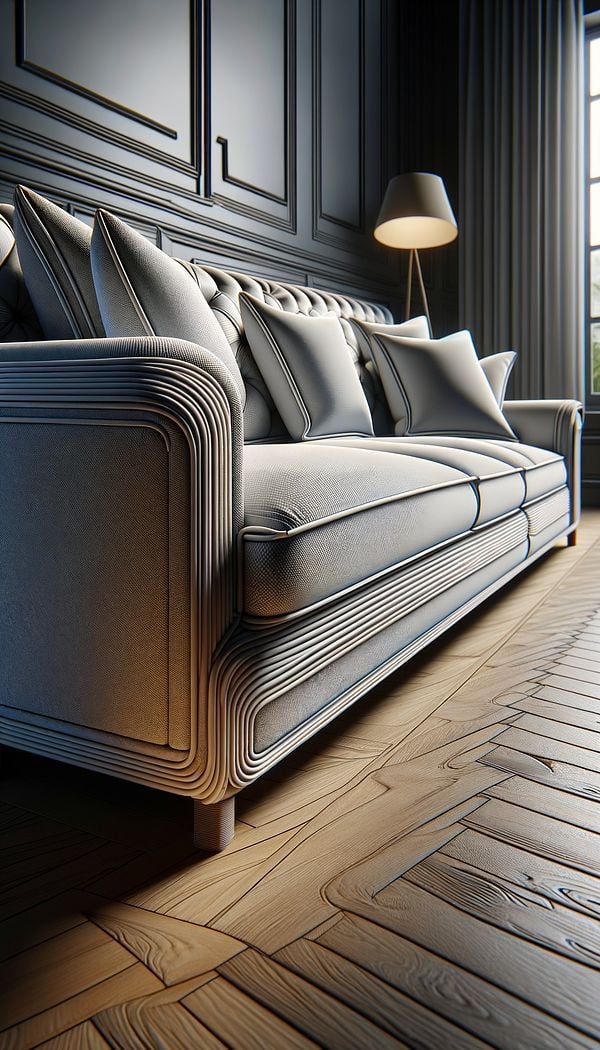What is Welting?
Welting is a decorative edge used in upholstery and soft furnishings.
Description
Welting, often referred to as piping, is a decorative trim or cord enclosed in a fabric tube, which is then sewn into the seams of cushions, furniture, and some types of decorative objects. This design element not only adds a tailored, finishing touch to soft furnishings and furniture but also serves a practical purpose. By reinforcing seams, welting helps to define the shape of cushions, pillows, and furniture edges, ensuring a crisp, structured appearance that can withstand frequent use.
The fabric used for welting can either match the main upholstery fabric for a seamless look or contrast with it to add an accent of color or texture. The choice of fabric and color can significantly influence the overall aesthetic and can be a vital element in interior design planning. Welting can be found in various settings, from traditional interiors with classic furniture types to modern spaces that utilize cleaner lines. The technique of adding welting is particularly associated with higher-quality furniture, where attention to detail and durability are prioritized.
Usage
In residential interiors, welting is commonly applied to sofa and chair cushions to enhance their aesthetic appeal and longevity. In commercial settings, it can be seen in hotel lobby furniture or the banquette seating of a restaurant, providing both comfort and style. Welting is also used in custom-made soft furnishings, such as decorative pillows, to add a personalized touch to interior spaces.
FAQs
-
What is the difference between welting and piping?
While welting and piping are often used interchangeably, welting specifically refers to the sewing technique and the inclusion of a cord within the fabric tube, which gives it more dimension and structure. Piping might not always include a cord and can be used more broadly for decorative embellishments beyond seams.
-
Can welting be added to existing furniture?
Yes, welting can be added to existing furniture by a professional upholsterer as part of a reupholstery project to refresh the look or improve durability.
-
Does welting come in different sizes?
Yes, the size of the welting can vary, depending on the thickness of the cord used inside the fabric tube. Larger welting can make a more dramatic design statement, while thinner welting offers a subtler choice.
-
Is welting only used in traditional interior design?
Not at all, welting is quite versatile and can be adapted to fit a variety of design styles, from traditional to contemporary. The fabric selection and where it's applied play a significant role in aligning with a specific decor style.
-
How is welting made?
Welting is made by wrapping a cord with a strip of fabric and then sewing this fabric tube onto the edges of upholstery or soft furnishings as a decorative trim.
-
Can I match the welting fabric to my upholstery fabric?
Yes, matching the welting fabric to your upholstery fabric creates a coherent look that emphasizes the silhouette of the furniture. Alternatively, using a contrasting fabric can highlight the welting as a distinct decorative element.
Practical Application
When considering adding welting to your furniture or soft furnishings, focus on the purpose it serves – whether for decorative appeal, durability, or both. Think about the overall design theme of your space and choose a welting fabric and color that complements or contrasts with your existing decor in a cohesive manner. Consulting with a professional upholstery service can provide guidance on the best approach for integrating welting into your interior design scheme.
-
Furniture Types599 articles
-
Decorating Principles & Elements330 articles
-
Textiles & Upholstery252 articles
-
BuffetA buffet is a long, low piece of furniture designed for storage and serving food.
-
Cast Iron FurnitureCast iron furniture refers to items of furniture made primarily from cast iron, a type of iron that has been melted, poured into molds, and allowed to solidify.
-
PassementeriePassementerie is the art of making elaborate trimmings or edgings of applied braid, gold or silver cord, embroidery, colored silk, or beads for clothing or furnishings.
-
EmpireEmpire refers to an opulent and majestic interior design style that originated in France during the First French Empire (early 19th century).
-
DavenportA small, upholstered sofa, often convertible into a bed.
